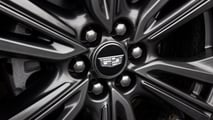
Maybe you’ve heard of the 2025 Cadillac Optiq. Maybe you haven’t. Maybe you recognize the -iq suffix as Cadillac’s new branding for electric vehicles, but can’t really tell one -iq vehicle from the next. I don’t blame you. But no matter your familiarity with Cadillac’s new "IQ" cars, there’s an underlying thread here: Cadillac is electrifying its lineup, fast.
And you know what? I like it.
| Quick Specs | 2025 Cadillac Optiq Luxury |
| Motor | Permanent-Magnet (Front) / Induction (Rear) |
| Battery | 85.0 Kilowatt-Hour Lithium-Ion |
| Output | 300 Horsepower / 354 Pound-Feet |
| EV Range | 302 Miles (est.) |
| Base Price | $56,390 |

The Optiq is part of a major shift for Cadillac. In recent years, the company’s introduced a slew of new electric vehicles under the IQ brand, mostly signified by model names ending in “-iq” (pronounced "ick," not "eek"). Joining the Optiq are models like the Lyriq, Vistiq, and Celestiq. The only departure from this rule is the Cadillac Escalade IQ, since pronouncing "Escaladiq" would be… weird. (I drove the IQ recently, and it made the Escalade feel important again.)
The Optiq is the cheapest vehicle in Cadillac’s new electric lineup, with a starting price of $56,390 with destination fees. It’s a two-row, five-seat crossover that shares a platform with the Chevrolet Equinox EV. Every Optiq has an 85.0-kilowatt-hour battery pack and a dual-motor, all-wheel-drive setup, with 300 horsepower and 354 pound-feet of torque. Cadillac estimates 302 miles of range, but the EPA hasn’t released official range estimates for the Optiq yet.
The Optiq has a full suite of standard safety equipment, including General Motors’ Super Cruise hands-free driver-assistance system. Super Cruise works on about 750,000 miles of mapped roads in the US and Canada, and in my experience, they’re often highways. The service is free for three years if you buy a Super Cruise-equipped car new, and it’s a subscription service thereafter. If you travel by highway a lot, it’s worth it.

Pros: Quiet & Stylish Interior, Unreal Sound System
There are currently only two trims of the Optiq: Luxury and Sport, which have similar prices but slightly different styling. The Luxury trim has bright chrome accents on the outside, while the Sport is more blacked-out. Luxury-trimmed Optiqs also get the option for a royal blue paint color called Coastal Blue Metallic, while the Sport’s special paint color is a bright-lava shade called Monarch Orange.
Inside the Optiq, there are four upholstery options: black, dark blue, autumn orange, and light gray with royal blue accents. I’d spec an Optiq with the Sport trim, Monarch Orange paint, and gray-and-royal-blue interior, but I couldn’t tell you if that’s good or not because my “tacky” radar has been broken for approximately 29 years. (I’m 29 years old.)


Driving the Optiq isn’t mind-blowing, but it is comfortable. The interior is so quiet that your ears have to readjust to the silence when you close the doors, and that noise cancellation continues on the road: When a harsh rainstorm hit the car, I didn’t realize how hurricane-like the conditions were until I got out. In the car, it just felt like a normal shower.
The only noise interruptions came from the Optiq’s safety systems. The front and side collision sensors were ultra-sensitive, beeping when I didn’t expect it. Sometimes they beeped at bollards on the side of the road, and sometimes they beeped at parked cars. I’d rather the car beep too much than too little, but it was jarring at first.

Cons: Not a Canyon Carver
There are a few drive modes in the Optiq: Tour, Sport, Snow/Ice, and My Mode. Sport mode changes the accelerator mapping to be more responsive, and the Optiq has plenty of power for its size and weight. I couldn’t safely slam my foot to the floor in the torrential rain, but when I did hit the pedal, the car was quick enough to make a normal buyer feel sporty.
That’s important, because Cadillac positions the Optiq as a sportier model. When I drove the car, the company pointed out its flat, aerodynamic windshield angle and large 20- to 21-inch wheels. They also encouraged us to drive it hard on winding roads.
I’ve driven two sporty EV crossovers hard on winding roads recently: the Optiq and the Hyundai Ioniq 5 N. Both made me nauseous. It’s likely the combination of silence and heavy curb weight in an EV, disorienting my body because it expects to feel gas, grunt, and sound.

While driving (or being driven) hard on curvy roads, the Optiq shifted its weight forward aggressively under braking and swayed in sharp turns. If you’re a buyer who likes ripping your cars on good roads—even electric crossovers—it’s worth seeing if they make you sick first.
But the Optiq isn’t about driving hard. It’s about the interior experience, and the thing that makes it is the sound system. It has a 19-speaker Dolby Atmos system standard, and I haven't stopped thinking about it.
Dolby Atmos is basically 3D sound; popular songs are mixed in Atmos to be "3D," where voices, instruments, and beats occur all around you. Mixers can place them above you, below you, in front of you, and behind you They can also put the voices and beats in motion, floating them around your body and head. (On the Optiq’s screen in the Amazon Music app, Atmos songs had a "Dolby Atmos" tag under the artist and song name. Cadillac says Atmos sound will be on certain models for 2025, and it’ll be available across the company’s entire EV lineup for 2026.)


In one song, “Hush” by The Marías, there’s an intro beat that lasts about 10 seconds. A regular speaker will just play that beat at you. But when I played the Atmos version in the Optiq, that same beat made a circle around me, as if a ball of sound was physically orbiting my head.
In many songs played through Atmos, the backup vocals came from the speakers above and behind me. It was angelic, as if the clouds parted and the singers were harmonizing down toward Earth.
There are only two drawbacks with this sound system: The first is that not all songs are in Atmos, and if you enjoy more obscure music like me, much of your playlist won’t be mixed for 3D. The second is that not every Atmos mix has the same depth—some of them lean heavily on the front speakers, making them sound more like a normal mix than an Atmos one.
Still, the experience is special. In my memory bank, the first time I heard a song in Atmos (in the Optiq, two weeks ago) is up there with the first time I went to one of those interactive movie theaters that spray water on you. It was that impressive.

The rest of the Optiq’s interior is high-class, too. My tester car had the light-gray color scheme with royal-blue accents, and there were all kinds of materials in it: woven yarn made from recycled materials, wood veneer made from recycled newspaper, silver speaker covers, and royal-blue cloth and plastic.
The interior styling reminded me of a current online trend where people joke about “Millennial burger joints” in America. You know the place: Appetizers are called “shareables,” the burger comes on a slab of wood, the ketchup comes in a metal tin, and desserts are milkshakes with entire pieces of cake on top. Millennials like commercialized quirk because it makes us feel unique, even if we’re all at the same burger joint ordering the same thing.
The interior of the Optiq feels like that too, and it’s not a bad thing. Cadillac says younger buyers are a target market for this car, and they’ll buy it—hopefully—because it’s designed for them.

I didn’t expect to like the Optiq as much as I do, because as a car enthusiast, it’s hard to feel something in a luxury electric SUV. They’re all fancy, quiet, and fast (sometimes too fast for a normal buyer). Perhaps you feel the same way, or you just haven’t learned to tell the -iq cars apart yet.
The Optiq is different. It may not be a hardcore canyon carver, but it’s special because it chooses a talent: making a buyer, their music, and their interior feel special, whether they’re driving to work, home, or that Millennial burger joint.
Just try not to drop the cake and milkshake on the seats, alright?
Competitors







2025 Cadillac Optiq Luxury







